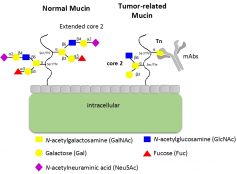
2015/09/15
The quest of anticancer vaccines: Deciphering the fine-epitope specificity of cancer-related monoclonal antibodies by combining microarray screening and STD-NMR
The expression of MUC1, a glycoprotein displaying complex oligosaccharides, is usually increased with aberrant glycosylation in tumour cells. In fact, the carbohydrate side chains are now incomplete and different epitopes, including the Tn antigen (α-GalNAc(1O-Ser/Thr), are now exposed to the immune system. Therefore, they could be employed for designing MUC1-based antitumor vaccines.
An international team, including research groups at the University of Lisbon, the University of Hokkaido, Pasteur Institute, CIB-CSIC, and CIC bioGUNE, has employed a multidisciplinary scientific approach to identify the molecular elements of the recognition region of the antigens for two different families of cancer-related mAbs.
The authors demonstrate that the combination of synthetic chemistry methods, mAb generation, glycan microarray technology, NMR, and computational methods provides a unique opportunity to investigate the functional significance of glycosylated peptides as antigens, getting detailed information for the design of tailored Tn-based vaccines, as MAG-Tn3. The obtained results results undercover the minimal structure features that modulate antigen-antibody interactions in the context of the development of Tn/MUC-1-based anticancer vaccines. In particular, the chemical nature of the amino acid sequence modulates the binding to anti-MUC1 mAbs. In contrast, for anti-Tn mAbs, the carbohydrate moiety is essential for the molecular recognition process.
For further information click here
See a large version of the first picture





